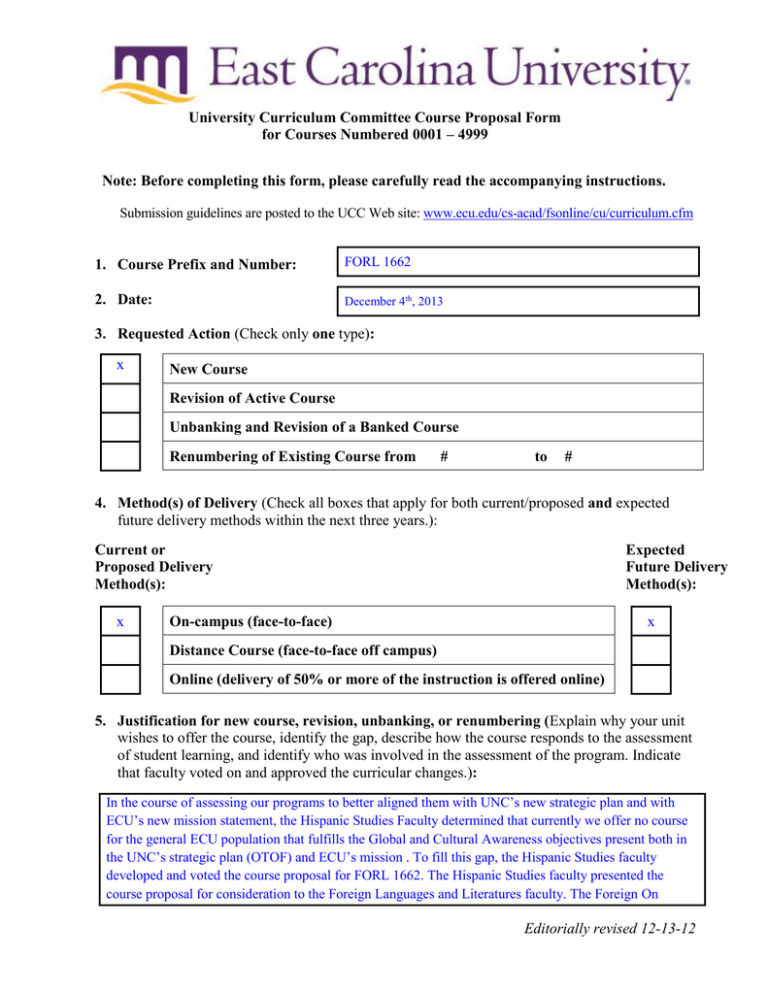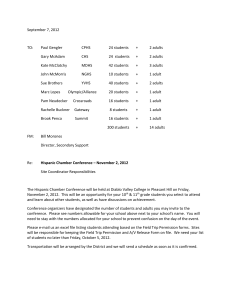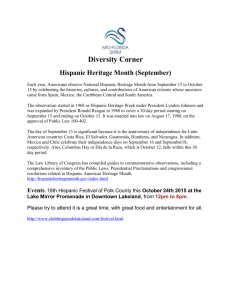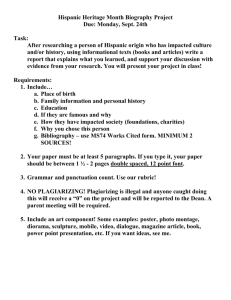FORL 1662
advertisement

University Curriculum Committee Course Proposal Form for Courses Numbered 0001 – 4999 Note: Before completing this form, please carefully read the accompanying instructions. Submission guidelines are posted to the UCC Web site: www.ecu.edu/cs-acad/fsonline/cu/curriculum.cfm 1. Course Prefix and Number: FORL 1662 2. Date: December 4th, 2013 3. Requested Action (Check only one type): x New Course Revision of Active Course Unbanking and Revision of a Banked Course Renumbering of Existing Course from # to # 4. Method(s) of Delivery (Check all boxes that apply for both current/proposed and expected future delivery methods within the next three years.): Current or Proposed Delivery Method(s): x Expected Future Delivery Method(s): x On-campus (face-to-face) Distance Course (face-to-face off campus) Online (delivery of 50% or more of the instruction is offered online) 5. Justification for new course, revision, unbanking, or renumbering (Explain why your unit wishes to offer the course, identify the gap, describe how the course responds to the assessment of student learning, and identify who was involved in the assessment of the program. Indicate that faculty voted on and approved the curricular changes.): In the course of assessing our programs to better aligned them with UNC’s new strategic plan and with ECU’s new mission statement, the Hispanic Studies Faculty determined that currently we offer no course for the general ECU population that fulfills the Global and Cultural Awareness objectives present both in the UNC’s strategic plan (OTOF) and ECU’s mission . To fill this gap, the Hispanic Studies faculty developed and voted the course proposal for FORL 1662. The Hispanic Studies faculty presented the course proposal for consideration to the Foreign Languages and Literatures faculty. The Foreign On Editorially revised 12-13-12 November 8th, 2013 the Foreign Languages and Literatures faculty voted in favor of this course proposal. 6. Course description exactly as it should appear in the next catalog: FORL 1662—Introduction to Hispanic Studies 3 FC:HU GD May not count toward SPAN major or minor. May not count toward foreign language requirement. Conducted in English; no knowledge of other languages required. Exploration of the field of Hispanic Studies through an examination of film, literature, and media. 7. If this is a course revision, briefly describe the requested change: n/a 8. Identify if the new/revised course will be a required and/or elective course in one of the degrees/minors/certificates offered by your unit. Is this course required (yes/no)? no Is this course an elective (yes/no)? 9. If writing intensive (WI) credit is requested, the Writing Across the Curriculum (WAC) Committee must approve WI credit prior to consideration by the UCC. yes Has this course been approved for WI credit (yes/no/NA)? n/a If Yes, will all sections be WI (yes/no/NA)? n/a 10. If service-learning (SL) credit is requested, the University Service-Learning Committee (USLC) must approve SL credit prior to consideration by the UCC. Has this course been approved for SL credit (yes/no/NA)? n/a If Yes, will all sections be SL (yes/no/NA)? n/a 11. If foundations curriculum (FC) credit is requested, the Foundations Curriculum and Instructional Effectiveness (FCIE) Committee must approve FC credit prior to consideration by the UCC. If FC credit has been approved by the FCIE committee, then check the appropriate box (check at most one): x English (EN) Science (SC) Humanities (HU) Social Science (SO) Editorially revised 12-13-12 Fine Arts (FA) Mathematics (MA) Health (HL) Exercise (EX) 12. Approval by the Council for Teacher Education (required for courses affecting teacher education programs): x Not Applicable Applicable (CTE has given their approval) 13. Course Credit: Per Week or Per Term = Credit Hours Lab Per Week or Per Term = Credit Hours s.h. Studio Per Week or Per Term = Credit Hours s.h. Practicum Per Week or Per Term = Credit Hours s.h. Internship Per Week or Per Term = Credit Hours s.h. Lecture Hours 3 s.h. 3 Other (e.g., independent study): s.h. Total Credit Hours 14. Anticipated yearly student enrollment: s.h. 3 150 15. Affected Degrees or Academic Programs: Degree(s)/Course(s) Change in Degree Hours n/a n/a n/a n/a 16. Overlapping or Duplication with Affected Units or Programs: x Not Applicable Applicable (Notification and/or Response from Units Attached) 17. Instructional Format(s): x Lecture Technology-mediated Lab Seminar Studio Clinical Editorially revised 12-13-12 Practicum Colloquium Internship Other (describe below): Student Teaching 18. Statements of Support: Please attach a memorandum, signed by the unit administrator, which addresses the budgetary and personnel impact of this proposal. x Current personnel is adequate Additional personnel are needed (describe needs below): x Current facilities are adequate Additional facilities are needed (describe needs below): x Initial library resources are adequate Initial resources are needed (give a brief explanation and estimate for cost of acquisition of required resources below): x Unit computer resources are adequate Additional unit computer resources are needed (give a brief explanation and an estimate for the cost of acquisition below): x ITCS Resources are not needed The following ITCS resources are needed (put a check beside each need): Mainframe computer system Statistical services Network connections Computer lab for students Editorially revised 12-13-12 Describe any computer or networking requirements of this program that are not currently fully supported for existing programs (Includes use of classroom, laboratory, or other facilities that are not currently used in the capacity being requested). Approval from the Director of ITCS attached Editorially revised 12-13-12 19. Course Syllabus Information: a. Textbook(s) and/or readings: author(s), name, publication date, publisher, and city/state/country. Indicate whether text is required or optional. Include ISBN. Students must buy: Allende, Isabel. The House of Spirits: A Novel. Trans. Magda Dogin. New York: Random House, 2005. ISBN 13 978-0553383805. (Required). Other readings distributed to students via hard copy and/or through ECU’s course management system: Chapters or selections from books: Allende, Isabel. My Invented Country. A Memoir. New York: Harper Collins, 2004. ISBN: 0060545674. (Required). Aznar, José María. Cartas a un joven español. Barcelona: Planeta, 2007. (Translation of selected letters provided by instructor). ISBN 9504918964. (Required). Bergard, Laird W. and Herbert S. Klein. “Population Growth and Dispersion, 1980-2005.” Hispanics in the United States. A Demographic, Social, and Economic History, 1980-2005. Cambridge: Cambridge UP, 2010. 63-98. ISBN 9780521889537. (Required). Columbus, Christopher. The Diario of Christopher Columbus's first voyage to America, 1492-1493. Norman : University of Oklahoma Press, 1989. ISBN 0806121017. (Required). Gracia, Jorge J.E. “What Should We Call Ourselves?” Hispanic/Latino Identity. A Philosophical Perspective. Malden: Blackwell, 2000. 1-26. ISBN 0631-217630. (Required). Las Casas, Bartolomé de. An Account Much Abbreviated of the Destruction of the Indies, with Related Texts. Indianapolis: Hackett, 2003. ISBN 0872206254. (Required). Mignolo, Walter D. “Introduction.” The Idea of Latin America. Oxford: Blackwell, 2005. ISBN 1405100869. (Required). Pope, Randolph D. “The Spanish American Novel from 1950 to 1975.” The Cambridge History of Latin American Literature. Ed. Roberto González Echevarría and Enrique Pupo-Walker. Cambridge: Cambridge U P, 1996. 226-242. ISBN 0521340705. (Required). Shaw, Donald L. The Post-Boom in Spanish American Fiction, Saratoga Spring: SUNY Press, 1998. 3-25. ISBN 0791438260. (Required). Silverblatt, Irene. “The Black Legend and Global Conspiracies: Spain, the Inquisition, and the Emerging Modern World”. Rereading the Black Legend. Ed. Margaret Greer, Walter Mignolo and Maureen Quilligan. The U of Chicago P, 2008. 99-117. ISBN 0226307220. (Required). Schwartz, Adam. “Mockery and Appropriation of Spanish in White Spaces: Perceptions of Latinos in the United States.” The Handbook of Hispanic Sociolinguistics. Ed. Manuel Díaz-Campos. Malden MA: Wiley-Blackwell, 2011. 646-663. ISBN 1405195002. (Required). Editorially revised 12-13-12 Stavans, Ilan. “Introduction: La jerga loca.” Spanglish. The Making of a New American Language. New York: Harper Collins, 2003. 1-61. ISBN 0060087765. (Required). Journal Articles: Callahan, Laura. “Native Speakers Attitudes Toward the Use of Non-Native Speaker. From George W to J. Lo.” Southwest Journal of Linguistics. 23:1 (2004). 1-28. ISBN B0027OWYUQ. (Required). Films: También la lluvia (2010). Dir. Icíar Bollacín. (Required). Isabel Allende: Tales of Passion. (Required). The House of Spirits (1993). Dr. Billy August. (Required). PBS Latino Americans Episode 1. (Required). Real Women Have Curves (2002). Dir. Patricia Cardoso. (Required) b. Course objectives for the course (student – centered, behavioral focus) Upon completion of this course, students will: Be able to conduct research in the field of Hispanic Studies. They will be able to: 1. Formulate research questions related to Hispanic studies. 2. Identify and search both print and electronic bibliographic indexes, locate resources in the library, and read widely about Hispanic studies. 3. Incorporate information gained from secondary sources into their own research. 4. Show familiarity with the field of Hispanic Studies. 5. Describe aspects of Hispanic Studies learned in the course. 6. Know how to carry out independent research in the field of Hispanic Cultures and Literatures. Be culturally competent. They will be able to: 1. Appreciate cultural differences between their own culture and Hispanic cultures on a broad range of topics 2. Identify and appreciate the values and perspectives of Hispanic cultures 3. Compare and contrast their own culture with Hispanic cultures in written presentations. 4. Interpret Hispanic texts that they view, read or hear about a variety of subjects related to topics examined in the course or in their own research. 5. Analyze Hispanic texts that they view, read or hear about topics for which they have conducted research. Editorially revised 12-13-12 c. Course topic outline Topics will vary depending on assigned instructor 's expertise. Topics will be among others: Appreciation of Spanish and Latin American Literature Colonialism/Colonization Convivencia Language and Authority Past and Future of Spanish in the Americas Representations of Race, Class and Gender in Spanish and Latin American Texts. Society and the Writer Transatlantic Dialogues in Hispanic Literature Women in Spanish and Latin American Literature What follows is the development of three of these topics into units during one semester. The number and content of units might change according to instructor’s expertise. FORL 1662—INTRODUCTION TO HISPANIC STUDIES—TENTATIVE WEEKLY ASSIGNMENTS WEEK TOPICS READINGS HUM GD GOAL GOAL 1, 3 1, 2 1, 2, 3 1, 2 Unit 1: Spanish Colonialism: The Past as Present 1 What the Spaniards saw when they arrived and why. Historical discourse and Hispanic Studies: the writing of history 2 Rereading the Black Legend (Leyenda negra). The ethics of colonization How knowledge is created in the Humanities. Columbus, Christopher. The Diario of Christopher Columbus's first voyage to America, 1492-1493. Norman : University of Oklahoma Press, 1989. Las Casas, Bartolomé de. An Account Much Abbreviated of the Destruction of the Indies, with Related Texts. Indianapolis: Hackett, 2003. Selections to be read by students: “Introduction to the Selection”, “On the Island of Cuba”, “On the New Kingdom of Granada” Silverblatt, Irene. “The Black Legend and Global Conspiracies: Spain, the Inquisition, and the Emerging Modern World”. Rereading the Black Legend. Ed. Margaret Greer, Walter Mignolo and Maureen Quilligan. The U of Chicago P, 2008. 99-117. How to read a scholarly article. Editorially revised 12-13-12 3 Guilt, exploitation, globalization: Use of the Black Legend in contemporary Spanish politics. Aznar, José María. Cartas a un joven español. Barcelona: Planeta, 2007. (Translation of selected letters provided by instructor). 1, 2, 3 1, 2 4 Guilt, exploitation, globalization: Recent artistic representation of the colonial period. Colonialism and the global economy. How to read a film. Mignolo, Walter D. “Introduction.” The Idea of Latin America. Oxford: Blackwell, 2005. 2, 3 1, 2 1, 2 1, 2 1, 2 1, 2 Screening and analysis of Bollacín, Icíar (director). También la lluvia (2010). [Screening outside class]. Unit 2: Appreciating Hispanic Literature 5 EXAM 1 Literature in its context. Why it is essential to know when and where in literature. (For Allende: Latin America Literature in the second half of the 20th century: history and literature). 6 Pope, Randolph D. “The Spanish American Novel from 1950 to 1975.” The Cambridge History of Latin American Literature. Ed. Roberto González Echevarría and Enrique Pupo-Walker. Cambridge: Cambridge U P, 1996. 226-242. Shaw, Donald L. The Post-Boom in Spanish American Fiction, Saratoga Spring: SUNY Press, 1998. 3-25. The author is alive! Does the author have a role in understanding what they wrote? (For Allende: analysis and commentary of author’s biography, interviews, and speeches). Allende, Isabel. My Invented Country. Selections to be read by students:“ An Old Enchanted House”, “Sirens Scanning the Sea”, “A Breath of History”, “This Country Inside my Head” Formulating research questions; how to search for secondary sources. [Screening outside class] 7 Learning to read like a literary critic. Expectations, Preparation, Reading strategies, Reflection and Application. (For Allende: House of Spirits). Reading and analysis of The House of Spirits 1, 2 1, 2 8 Learning to read like a literary critic. Expectations, Preparation, Reading and analysis of The House of Spirits 1, 2 1, 2 Screening of: Isabel Allende: Tales of Passion. Editorially revised 12-13-12 Reading strategies, Reflection and Application. (For Allende: The House of Spirits). 9 Adaptation to film, assimilation to culture: Screening and analysis of August, Billy (director). The House of Spirits (1993). The House of the Spirits (film) [Screening outside class]. 3 1, 2 1, 2, 3 1, 2 Unit 3: My neighbor, myself: Hispanics in the US 10 EXAM 2 Introduction to Hispanic populations in the US: sociology, economics, and Hispanic Studies How to use data. Where do they come from, where they are and possible reasons why. Bergard, Laird W. and Herbert S. Klein. “Population Growth and Dispersion, 19802005.” Hispanic in the United States. A Demographic, Social, and Economic History, 1980-2005. Cambridge: Cambridge UP, 2010. 63-98 Screening of PBS Latino Americans Episode 1. [Screening outside class] 11 Labels. Understanding labels such as Hispanic, Latino, Chicano, who uses them and why. Philosophical implications of the labels. Gracia, Jorge J.E. “What Should We Call Ourselves?” Hispanic/Latino Identity. A Philosophical Perspective. Malden: Blackwell, 2000. 1-26. 1, 3 1,2 12 Hispanic and Spanish. Attitudes toward Language in Hispanic and non-Hispanic populations: a question of sociolinguistics or social class? Callahan, Laura. “Native Speakers Attitudes Toward the Use of Non-Native Speaker. From George W to J. Lo.” Southwest Journal of Linguistics. 23:1 (2004). 1-28. 1, 3 1, 2 1, 3 1, 2 Schwartz, Adam. “Mockery and Appropriation of Spanish in White Spaces: Perceptions of Latinos in the United States.” The Handbook of Hispanic Sociolinguistics. Ed. Manuel Díaz-Campos. Malden MA: Wiley-Blackwell, 2011. 646-663 12 Code switching, Bilingualism Toribio, Almeida Jacqueline. “Code-switching among US Latinos.” The Handbook of Editorially revised 12-13-12 Hispanic Sociolinguistics. Ed. Manuel DíazCampos. Malden MA: Wiley-Blackwell, 2011. 530-552. 13 Spanglish, is it a language? Stavans, Ilan. “Introduction: La jerga loca.” Spanglish. The Making of a New American Language. New York, Harper Collins, 2003. 1-61. 1, 3 1, 2 14 Acculturation and Biculturalism of Hispanics in the US. Screening and analysis of Cardoso, Patricia, (director). Real Women Have Curves. (2002) 2 1, 2 2 1, 2 [Screening outside class] 15 Course conclusion Consultations about final exam/essay d. List of course assignments, weighting of each assignment, and the grading/evaluation system for determining the course grade. Evaluation Quizzes: First Exam: Second Exam: Final Exam ( essay): Research proposal: 2 Annotated bibliographical entries 20% 15% 15% 25% 15% 10% Grading Scale A = 93 % and above A- = 90 – 92 % B+ = 87 – 89 % B = 83 – 86 % B- = 80 – 82 % C+ = 77 – 79 % C = 73 – 76 % C- = 70 – 72 % D+ = 67 – 69 % D = 63 – 66 % D- = 60 – 62 % F = below 60 % List of Assignments Weekly Quizzes On the first day of each week, class will begin class with a quiz that covers all material from lectures and Editorially revised 12-13-12 readings of the prior week. Exams (2) 2 exams covering materials from lectures and readings and knowledge of methodology used in secondary sources studied in class to show understanding of research methods used in the humanities. Research Proposal In week 5 of the course students need to submit for approval a topic for a research project related to the course. In week 8 of the course, students will submit the proposal. The proposal must include basic bibliography of previous research on the topic, research questions and a methodology for the study. Limit: 3 pages. Annotated Bibliography entries After evaluation by instructor of research proposal, instructor will assign 2 of the bibliographical entries for the student to write annotated entries. Final Exam 1½-2 page, single-spaced analysis of a primary text selected by the instructor. The student must identify a theme and propose a thesis using evidence from the text examined. Students are required to use secondary sources and key concepts discussed in class to support their thesis. Citations will be made using MLA style. NOTE: Beginning in fall of 2012, grading scales should reflect the implementation of the “+/-” grading system adopted by the faculty. Editorially revised 12-13-12





